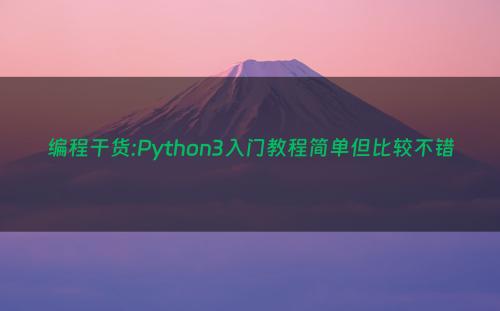1 你好
复制代码代码如下 :

# 打开新窗口 ,输入 :
#! /usr/bin/python
# -*- coding: utf8 -*-
s1=input("Input your name:")
print(" 你好,%s" % s1)
'''
知识点 :
* input(" 某字符串 ")函数 :显示 "某字符串 ",并等待用户输入 .
* print() 函数 :如何打印 .
* 如何应用中文
* 如何用多行注释
'''
2 字符串和数字
但有趣的是 ,在 javascript 里我们会理想当然的将字符串和数字连接 ,因为是动态语言嘛 .但在 Python 里有点诡异 ,如下 :
复制代码代码如下 :
#! /usr/bin/python
a=2
b="test"
c=a+b
运行这行程序会出错 ,提示你字符串和数字不能连接 ,于是只好用内置函数进行转换
复制代码代码如下 :
#! /usr/bin/python # 运行这行程序会出错 ,提示你字符串和数字不能连接 ,于是只好用内置函数进行转换
a=2
b="test"
c=str(a)+b
d="1111"
e=a+int(d)
#How to print multiply values
print ("c is %s,e is %i" % (c,e))
'''
知识点 :
* 用 int 和 str 函数将字符串和数字进行转换
* 打印以 # 开头,而不是习惯的 //
* 打印多个参数的方式
'''
3 列表
复制代码代码如下 :
#! /usr/bin/python
# -*- coding: utf8 -*- # 列表类似 Javascript 的数组 ,方便易用
# 定义元组
word=['a','b','c','d','e','f','g'] # 如何通过索引访问元组里的元素
a=word[2]
print ("a is: "+a)
b=word[1:3]
print ("b is: ")
print (b) # index 1 and 2 elements of word.
c=word[:2]
print ("c is: ")
print (c) # index 0 and 1 elements of word.
d=word[0:]
print ("d is: ")
print (d) # All elements of word. # 元组可以合并
e=word[:2]+word[2:]
print ("e is: ")
print (e) # All elements of word.
f=word[-1]
print ("f is: ")
print (f) # The last elements of word.
g=word[-4:-2]
print ("g is: ")
print (g) # index 3 and 4 elements of word.
h=word[-2:]
print ("h is: ")
print (h) # The last two elements.
i=word[:-2]
print ("i is: ")
print (i) # Everything except the last two characters
l=len(word)
print ("Length of word is: "+ str(l))
print ("Adds new element")
word.append('h')
print (word) # 删除元素
del word[0]
print (word)
del word[1:3]
print (word)
'''
知识点 :
* 列表长度是动态的 ,可任意添加删除元素 .
* 用索引可以很方便访问元素 ,甚至返回一个子列表
* 更多方法请参考 Python 的文档
'''
4 字典
复制代码代码如下 :
#! /usr/bin/python
x={'a':'aaa','b':'bbb','c':12}
print (x['a'])
print (x['b'])
print (x['c'])
for key in x:
print ("Key is %s and value is %s" % (key,x[key]))
'''
知识点 :
* 将他当 Java 的 Map 来用即可 .
'''
5 字符串
比起 C/C++,Python 处理字符串的方式实在太让人感动了 .把字符串当列表来用吧 .
复制代码代码如下 :
#! /usr/bin/python
word="abcdefg"
a=word[2]
print ("a is: "+a)
b=word[1:3]
print ("b is: "+b) # index 1 and 2 elements of word.
c=word[:2]
print ("c is: "+c) # index 0 and 1 elements of word.
d=word[0:]
print ("d is: "+d) # All elements of word.
e=word[:2]+word[2:]
print ("e is: "+e) # All elements of word.
f=word[-1]
print ("f is: "+f) # The last elements of word.
g=word[-4:-2]
print ("g is: "+g) # index 3 and 4 elements of word.
h=word[-2:]
print ("h is: "+h) # The last two elements.
i=word[:-2]
print ("i is: "+i) # Everything except the last two characters
l=len(word)
print ("Length of word is: "+ str(l))
中文和英文的字符串长度是否一样 ?
复制代码代码如下 :
#! /usr/bin/python
# -*- coding: utf8 -*- s=input(" 输入你的中文名 ,按回车继续 ");
print (" 你的名字是 : " +s)
l=len(s)
print (" 你中文名字的长度是 :"+str(l))
知识点 :
类似 Java,在 python3 里所有字符串都是 unicode, 所以长度一致 .
6 条件和循环语句
复制代码代码如下 :
#! /usr/bin/python # 条件和循环语句
x=int(input("Please enter an integer:"))
if x<0:
x=0
print ("Negative changed to zero")
elif x==0:
print ("Zero")
else:
print ("More")
# Loops List
a = ['cat', 'window', 'defenestrate']
for x in a:
print (x, len(x)) # 知识点 :
# * 条件和循环语句
# * 如何得到控制台输入
7 函数
复制代码代码如下 :
#! /usr/bin/python
# -*- coding: utf8 -*-
def sum(a,b):
return a+b
func = sum
r = func(5,6)
print (r) # 提供默认值
def add(a,b=2):
return a+b
r=add(1)
print (r)
r=add(1,5)
print (r) 一个好用的函数
#! /usr/bin/python
# -*- coding: utf8 -*-
# The range() function
a =range (1,10)
for i in a:
print (i)
a = range(-2,-11,-3) # The 3rd parameter stands for step
for i in a:
print (i)
知识点 :
Python 不用 {} 来控制程序结构 ,他强迫你用缩进来写程序 ,使代码清晰 . 定义函数方便简单
方便好用的 range 函数
8 异常处理
复制代码代码如下 :
#! /usr/bin/python
s=input("Input your age:")
if s =="":
raise Exception("Input must no be empty.")
try:
i=int(s)
except Exception as err:
print(err)
finally: # Clean up action
print("Goodbye!")
9 文件处理
对比 Java,python 的文本处理再次让人感动
复制代码代码如下 :
#! /usr/bin/python
spath="D:/download/baa.txt"
f=open(spath,"w") # Opens file for writing.Creates this file doesn't exist.
f.write("First line 1.\n")
f.writelines("First line 2.")
f.close()
f=open(spath,"r") # Opens file for reading
for line in f: print(" 每一行的数据是 :%s"%line)
f.close()
知识点 :
open 的参数 :r 表示读 ,w 写数据 ,在写之前先清空文件内容 ,a 打开并附加内容 . 打开文件之后记得关闭
10 类和继承
复制代码代码如下 :
class Base:
def __init__(self):
self.data = []
def add(self, x):
self.data.append(x)
def addtwice(self, x):
self.add(x)
self.add(x)
# Child extends Base
class Child(Base):
def plus(self,a,b):
return a+b
oChild =Child()
oChild.add("str1")
print (oChild.data)
print (oChild.plus(2,3))
''' 知识点 :
* self: 类似 Java 的 this 参数
'''
11 包机制
每一个 .py 文件称为一个 module,module 之间可以互相导入 .请参看以下例子 :
复制代码代码如下 :
# a.py
def add_func(a,b):
return a+b
# b.py
from a import add_func # Also can be : import a
print ("Import add_func from module a")
print ("Result of 1 plus 2 is: ")
print (add_func(1,2)) # If using "import a" , then here should be "a.add_func"
module 可以定义在包里面 .Python 定义包的方式稍微有点古怪 ,假设我们有一个 parent 文件 夹,该文件夹有一个 child 子文件夹 .child 中有一个 module a.py . 如何让 Python 知道这个
文件层次结构 ?很简单 ,每个目录都放一个名为 _init_.py 的文件 .该文件内容可以为空 .这个
层次结构如下所示 :
parent
--__init_.py
--child
-- __init_.py
--a.py
b.py 那么 Python 如何找到我们定义的 module? 在标准包 sys 中,path 属性记录了 Python 的包路
径.你可以将之打印出来 :
import sys
print(sys.path) 通常我们可以将 module 的包路径放到环境变量 PYTHONPATH 中,该环境变量会自动添加到
sys.path 属性 .另一种方便的方法是编程中直接指定我们的 module 路径到 sys.path 中:
复制代码代码如下 :
import sys
import os
sys.path.append(os.getcwd()+'\\parent\\child')
print(sys.path)
from a import add_func
print (sys.path)
print ("Import add_func from module a")
print ("Result of 1 plus 2 is: ")
print (add_func(1,2))
知识点 :
如何定义模块和包
如何将模块路径添加到系统路径 ,以便 python 找到它们
如何得到当前路径
12 内建帮助手册
对比 C++,Java 的突出进步是内建 Javadoc 机制 ,程序员可以通过阅读 Javadoc 了解函数用
法.Python 也内建了一些方便函数以便程序员参考 .
dir 函数 : 查看某个类 /对象的方法 . 如果有某个方法想不起来 ,请敲 dir. 在 idle 里,试试 dir(l
ist) help 函数 : 详细的类 /对象介绍 . 在 idle 里, 试试 help(list)
